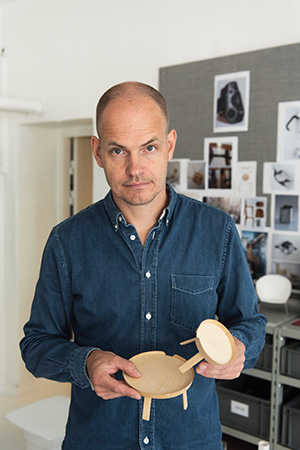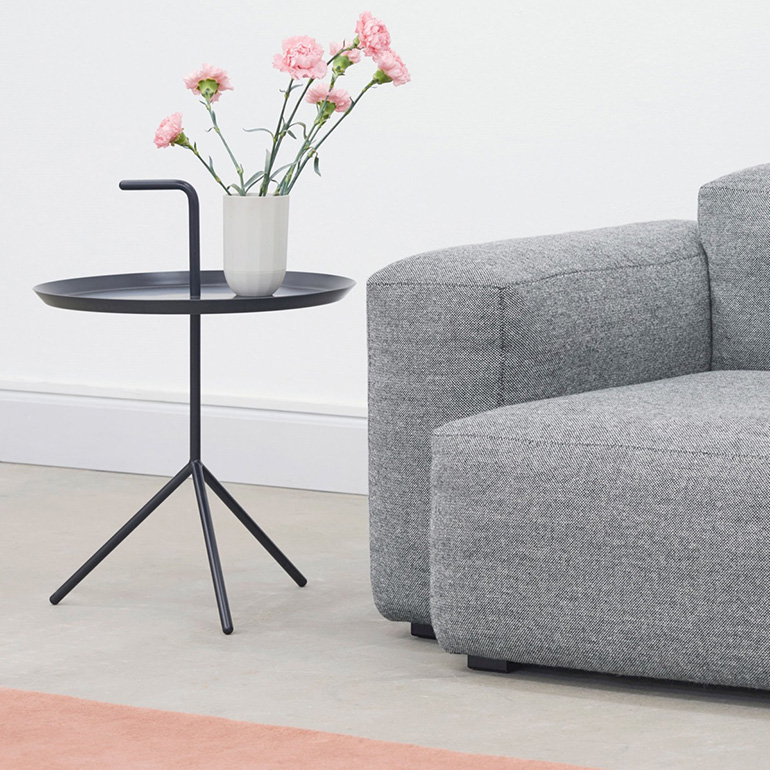10 Questions With… Thomas Bentzen
 Danish design culture is “a natural part of me,” reveals Thomas Bentzen, who lives with his wife and three children—one named after a famous Finnish designer—in a 1,900-square-foot apartment full of prototypes in central Copenhagen. With a mission to create simple, useful products and aiming for the same qualities that Danish designers strove for more than half a century ago—functionality, rationality, honesty, and craftsmanship—Bentzen has designed for the likes of Bang & Olufsen, Louis Poulsen, Menu, Muuto, and Royal Copenhagen to name a few, out of his namesake design studio. Most recently, at the Stockholm Furniture & Light Fair, Muuto unveiled Bentzen’s Linear Steel series, a sleek line of powder-coated steel outdoor furniture drawing from classic picnic silhouettes. Bentzen sat down with Interior Design to reveal more about the new outdoor series, reflect on how his interests now are quite similar to those he had as a child, and pay tribute to a classic light that sits in his living room.
Danish design culture is “a natural part of me,” reveals Thomas Bentzen, who lives with his wife and three children—one named after a famous Finnish designer—in a 1,900-square-foot apartment full of prototypes in central Copenhagen. With a mission to create simple, useful products and aiming for the same qualities that Danish designers strove for more than half a century ago—functionality, rationality, honesty, and craftsmanship—Bentzen has designed for the likes of Bang & Olufsen, Louis Poulsen, Menu, Muuto, and Royal Copenhagen to name a few, out of his namesake design studio. Most recently, at the Stockholm Furniture & Light Fair, Muuto unveiled Bentzen’s Linear Steel series, a sleek line of powder-coated steel outdoor furniture drawing from classic picnic silhouettes. Bentzen sat down with Interior Design to reveal more about the new outdoor series, reflect on how his interests now are quite similar to those he had as a child, and pay tribute to a classic light that sits in his living room.
Interior Design: Could you tell us a little more about the Linear Steel series?
Thomas Bentzen: The Linear Steel series represents a very Scandinavian approach to outdoor furniture. It’s super simple and rational, durable and very understated, with subtle details—such as the folded edges and seamless meetings of leg and tabletop. The corner joint—where leg, apron, and tabletop come together—is the strong point where all parts meet, and that is the detail that adds distinctiveness. In terms of color, we wanted the series to have a subtle and understated sentiment along with a modern expression. It’s inspired by archetypal wooden furniture.
ID: What do you consider “archetypal wooden furniture?”
TB: For me that would be something such as a chair with four legs, all made in the wood Shaker style, maybe with a woven seat. I instantly think of the J39 by Børge Mogensen, now produced by Fredericia or the J46 by Poul M. Volther. Same goes for a table: four legs, one in each corner, strong and durable, very simple—I like tables that way.

ID: Do you think there’s an outdoor furnishings trend at the moment? It seems as if a lot of firms in Scandinavia are now launching their first lines.
TB: This movement is a natural evolution of the new wave of furniture brands from Scandinavia. Why not offer the same good perspective on design for the outdoors as you would indoors? Maybe there’s also a need for a different type of outdoor furniture—more urban and smaller in size than the big classic outdoor furniture environments, such as you would see in huge villas that overlook the French Riviera.
ID: What else have you completed recently?
TB: The Cover lounge chair, which I also designed for Muuto, launched this past January at IMM Cologne. The design is a natural extension of the Cover chair for Muuto, made for a lounge or living room environment, and a low open chair—in which I continue to work with a mix of thin veneer and solid wood. Veneer is one of my favorite materials when it comes to furniture. In fact, the transition from chair to a lounge version wasn’t easy at all. We needed to have a very different seating position, yet we needed to maintain the close connection, shape-wise, to the chair. I am very pleased with the outcome.
At Salone del Mobile 2018 in Milan, we launched the lacquered steel Enfold sideboard for Muuto. For this design, I took an industrial approach to the classic sideboards that I grew up with—mixing together the old heavy wooden sideboards often found in the living room, housing the most beloved items in the family, with the mid-century metal cabinets found in offices. Enfold is a more industrial and lighter version of the two typologies. The curvy sliding doors are not only a reference to the rolling covers but also a pattern that adds strength and durability to the design. Enfold has both a very simple and elegant appearance—yet is a complex and rational product.

ID: What’s upcoming for you?
TB: At Salone del Mobile this April, we will launch the next step in the Linear series for Muuto—a design for indoor use. I’m also working to add another design to the Linear Steel series. Some new products for other Danish brands will be released this Spring as well.
ID: How do you use social media?
TB: I only use Instagram (I’m @thomas_bentzen_id), and I follow a lot of colleagues, design companies, musicians, artists, museums, and galleries like @v1gallery. Skiing accounts are another big thing for me, like @freerideworldtour.

ID: What are you reading?
TB: A book about the painter Philip Guston and his drawings: “Philip Guston Works on Paper” by Christoph Schreier, Poul Erik Tojner, and Isabel Dervaux. I’m also reading “Bad News,” a novel by Edward St Aubyn.
ID: How did your childhood influence where you are today?
TB: I would draw a lot as a kid—trucks, Formula One race cars, things related to space and spacemen, often side views like you’d see in a technical drawing…and a lot of cowboy and space stuff, in a cartoonish way. Drawing was my favorite thing, next to stacking a lot of Lego systems while I was listening to audiobooks. More or less, it’s the same as I do today: draw, build models, and listen to records.

ID: Who in the industry do you particularly admire?
TB: Hard to name one! I am a big fan of French architect and designer Jean Prouvé. His industrial engineering approach to design is very rational and functional and I really like the aesthetics that came out of it. Then of course Alvar Aalto (my son is actually named after him). The furniture he designed is amazing—so simple and still look as if they were designed today. I have also always enjoyed the work of London-based Industrial Facility and its co-founder Sam Hecht. It’s very precise and refined—as you can see in their Bell clock, which is in my bedroom.
ID: Is there another furnishing object in your home that has particular value to you?
TB: I am also a very big fan of Achille Castiglioni and the lamps he designed for Flos—and I try to collect them all. He made such strong designs, filled with character and history, with his playful approach to ready-made industrial objects. The Toio floor lamp by Castiglioni and Pier Giacomo Castiglioni is one of my favorites—basically a car headlamp and fishing rod on top of a transformer. It’s an insane idea with an amazing result and it stands in our living room.
Interested in finding out about the products and passions of other top designers? Check out recent 10 Questions With… Sebastian Herkner and Dechem.


